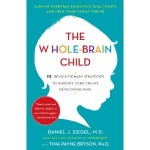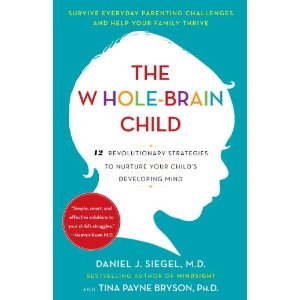 The last strategy in The Whole-Brain Child is directed at helping children navigate the conflict they will inevitably have with other children (school, siblings, etc.) by using some mindsight skills. Mindsight is “understanding our own mind as well as understanding the mind of another,” and understanding the mind of another is the focus of Strategy 12: Connection Through Conflict.
The last strategy in The Whole-Brain Child is directed at helping children navigate the conflict they will inevitably have with other children (school, siblings, etc.) by using some mindsight skills. Mindsight is “understanding our own mind as well as understanding the mind of another,” and understanding the mind of another is the focus of Strategy 12: Connection Through Conflict.
Earlier in the chapter, Siegel and Bryson speak about the brain as being wired for “we.” They say, “… what happens between brains has a great deal to do with what happens within each individual brain. Self and community are fundamentally interrelated, since every brain is continually constructed by its interactions with others.” And of course one of the interactions that will happen between brains is conflict, so what do we teach our children? We teach them to:
- Recognize the other’s point of view
- “Read” nonverbal communication
- Repair and make things right
When we teach our children to recognize the other’s point of view, we are trying to elicit empathy. We can do this by asking them how they think another person feels or why they think someone reacted a certain way. As we get our children to recognize other points of view, we also want them to read nonverbal communication. We want them to understand body language. And the last (and possibly the hardest) is repair. We do want our children to say sorry, but sometimes they need to take some further steps to repair the parts of their relationships that have been ravaged by conflict. “Sometimes a sincere a apology is enough, especially when combined with honesty and sincerity… but kids also need to learn what it means to go the extra mile and take specific steps toward reconciliation.”
So what does this look like? Well, with Elise, a 4 year old, and Maggie, a 1 year old, we are not making great leaps and strides here, but we are laying a foundation. When a toy is grabbed away, when someone is accidentally (or not) shoved, we ask Elise how she thinks a sobbing Maggie feels. Then we have Elise check on Maggie, try to hug Maggie or rub her back, and if the conflict involves a toy we try to work out sharing or trading. We also encourage Elise to use words (not just grabbing) when they have a conflict, so that she can be a model for Maggie. And frankly, this is a daily occurrence at our house, so we are going to keep practicing and encouraging empathy in our children.
As much as I would like to have conflict-free days, Siegel and Bryson say, “If [our children] are going to be in relationships, they’re going to face quarrels and disagreements,” so let’s teach them these mindsight skills. When “children develop these mindsight skills, they can learn to balance the importance of their own inner lives with those of others.” Learning to balance what you are feeling and what another person is feeling is a difficult task, so we need to start helping our children sort through conflict.
I know some of these strategies sound like common sense, but honestly, they are not my first instinct. My first instinct is to stop the situation, the sooner the better, not to mediate who gets the Dora microphone first, but my kids will benefit from me taking the time to implement these strategies. They will benefit from me resisting my first instinct, taking a deep breath, and calmly teaching them how to consider one another and make the necessary repairs to their relationship.
I have spent the summer months summarizing each strategy in The Whole-Brain Child, but I want you know that there is so much in this book. At the end of each strategy, the authors include illustrations that show families acting out the strategies. Then at the end of each chapter, the book provides illustrations to show how to teach the concepts about the brain to your child, and each chapter includes a section called Integrating Ourselves which is directed at us, the parents. Taking the time to read and process the Integrating Ourselves content might be difficult, but understanding your past and how it affects your relationships will help you see where you can make changes and better connect with your children.
Pick up a copy of The Whole-Brain Child so you can further explore the concepts presented in the book and practice the strategies with your children. And once you’re done practicing, well, practice some more. I’m sure your children will present you with plenty of opportunities—I know mine will.


You could have noted very interesting points ! ps decent site.
93836 759003Thank you for the sensible critique. Me and my neighbor were just preparing to do some research about this. We got a grab a book from our local library but I feel I learned far more from this post. I
Cómo se puede determinarlo?
I think this is among the most vital info for me. And i am glad
reading your article. But wanna remark on few general things, The web site style is great, the articles is really nice : D.
Good job, cheers
hiya everyone, I used to be just checkin out this website and i also really enjoy the inspiration of this article, and have nothing to do, therefore if anyone would wish to to get an enjoyable convo regarding this, please check out my website on yahoo, i’m michael duivis jessica meautle
Do you have any video of that? I’d want to find out more details.
Zune and iPod: Most people compare the Zune to the Touch, but after seeing how slim and surprisingly small and light it is, I consider it to be a rather unique hybrid that combines qualities of both the Touch and the Nano. It’s very colorful and lovely OLED screen is slightly smaller than the touch screen, but the player itself feels quite a bit smaller and lighter. It weighs about 2/3 as much, and is noticeably smaller in width and height, while being just a hair thicker.
Hi, I’ve been a lurker around your blog for a few months. I love this article and your entire site! Looking forward to reading more!
I have discovered that wise real estate agents all around you are warming up to FSBO Promoting. They are noticing that it’s in addition to placing a poster in the front area. It’s really in relation to building associations with these suppliers who at some point will become purchasers. So, if you give your time and energy to aiding these dealers go it alone the “Law connected with Reciprocity” kicks in. Interesting blog post.
531205 365124Real informative and amazing anatomical structure of topic material , now that
31948 851328As I website possessor I believe the content material here is really great , regards for your efforts. 30005
Awesome blog article.Really looking forward to read more. Much obliged.
I’m impressed, I ought to say. Honestly rarely do I encounter a weblog that is both educative and entertaining, and let me tell you, you’ve hit the nail on the head. Your idea is outstanding; the problem is something that not sufficient consumers are speaking intelligently about. I’m particularly happy that I stumbled across this in my search for some thing relating to this.
jordan shoes for sale
the internet position making use of my own ideal Facebook or else facebook crew: )
Hi there it’s me, I am also visiting this web page
on a regular basis, this site is in fact nice and the users are truly sharing good thoughts.
579616 201760Sweet internet internet site , super style and style , rattling clean and utilize genial . 692131
I like the helpful info you provide in your articles. I will bookmark your weblog and check again here regularly. I’m quite certain I’ll learn plenty of new stuff right here! Best of luck for the next!
683935 659215Well worded post will be sharing this with my readers this evening 299836
Dear P&G;
You give me yet another reason to avoid any of your products, just by your lack of moral concern about your environment and the people you fleece in the name of the almighty $DOLLAR$.
You would prevent so much pollution from the residual effects making of these “Plastic Beads” to the accumulation of the beads that make their way to our water supply by replacing it with something biodegradable .
How you continue to proffer off of the stupidity of the mass is shameful and embarrassing to all mankind you pretend to represent.
You can resolve this problem sooner, you just do not want to because of the financial wheeling s and dealings you are so deeply involved in.
22144 906240I enjoy your composing style, do carry on creating! I will likely be back! 83741